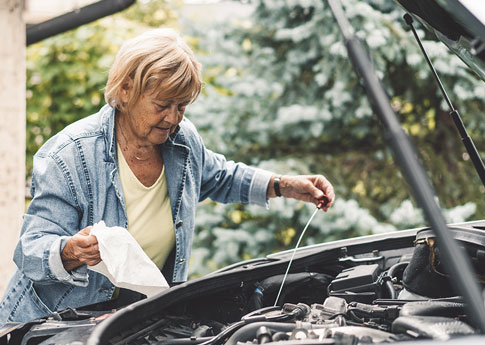12 effective tips to extend the lifespan of your vehicle

Nowadays, both gas and electric cars can be driven for up to 300,000 kilometres without major repairs, provided they are properly maintained. Here are 12 tips to prolong the life of your vehicle and prevent early wear and tear.
1) Follow the maintenance schedule in the owner’s manual
To ensure that your vehicle’s manufacturer’s warranty is upheld, you must follow the mechanical maintenance schedule in your owner’s manual down to the letter. Once the warranty has expired, factor in your annual kilometrage and the road conditions where you drive (city, highway, gravel roads, etc.) to establish the maintenance schedule that best suits your vehicle. Hint: Refer to your owner’s manual for maintenance tips and answers to your questions, and observe the frequency of oil and filter changes.
2) Respond quickly to check engine and other warning lights
Is the check engine warning light showing on your dashboard? Head to your garage as soon as possible to have the problem diagnosed. Good to know: It’s always best to act quickly, for if you decide to wait to have your vehicle repaired and another, more serious problem occurs, you won’t know because your light will already be activated.
3) Check oil and fluids and have your vehicle inspected
4) Choose quality replacement auto parts
Stay away from the cheapest auto parts listed in the catalogue. Instead, choose parts of intermediate or even higher quality, if your budget allows. You can also consider used or reconditioned parts. Reliable companies offer verified and guaranteed parts. Did your original shock absorbers last at least 10 years? That is a good indicator of the lifespan of quality auto parts. Furthermore, if you decide to sell your vehicle sooner than expected, you may be able to get a better price. Hint: Keep all invoices documenting your car’s maintenance and repair history, as well as the purchase of new or used parts.
5) Wax your car twice a year
A good wax will protect your vehicle’s finish, prevent dirt from adhering to the paint, and make it easier to clean. In the long term, your bodywork can only benefit from a protective wax applied twice a year, preferably in the autumn and spring. Be methodical when applying the product and follow the manufacturer’s instructions, otherwise you may waste your time and end up without the benefits for your car. Good to know: Avoid sunny days when applying wax. Sun and heat can lead to rapid drying, make wiping difficult, cause staining, and compromise product bonding.
6) Apply a rustproofing treatment
A rustproofing treatment, applied in late summer or early autumn, is recommended if you intend to keep your vehicle for a long time—or even for a leased vehicle you might decide to buy at the end of your lease. Besides, it’s never too late to start! If your dealer tells you that such treatment is not advisable for your electric vehicle, as it could void your manufacturer’s warranty, ask for more information! Our mobility experts report that most owner’s manuals don’t mention anything of the sort. Good to know: CAA-Quebec members can claim a discount on the price of a complete rustproofing treatment, thereby avoiding premature wear and tear on their vehicle.
7) Soften rubber seals
By keeping your rubber seals lubricated, you’ll be able to prevent water leaks into your car’s interior. Plus, you’ll have less trouble opening the doors after bouts of freezing rain. Lubricate the rubber seals on the doors, trunk and tailgate twice a year, preferably when the seasons change. Hint: For best results, choose lubricants specially designed for automotive use.
8) Maintain your electric vehicle’s brakes
Brakes on electric vehicles are generally less stressed due to their regenerative braking technology, especially those equipped with the “One-Pedal Drive” function. It’s advisable to have your braking system inspected at least once a year. Your mechanic can remove the caliper and brake pads, thus ensuring that nothing sticks and to prevent rust. Good to know: Failure to do so can quickly wipe out the savings on fuel you’ve achieved with your EV.
9) Monitor your EV’s air-conditioning system
In an electric vehicle, a faulty air-conditioning system leads to far more serious consequences than in a gas-powered vehicle, as it also plays a role in the battery’s thermal conditioning (maintaining the battery’s temperature at an optimum level). Good to know: A fault in your EV’s air-conditioning system can jeopardize the battery’s proper operation as well as its lifespan.
10) Wash your vehicle on a regular basis
In winter and summer alike, keeping your car clean (video available in French only) will preserve it for longer. Keep your vehicle’s bodywork clean and wash down the mouldings, wheels and all the way under the chassis with pressurized water, where dirt and salt build up in winter. Hint: If you prefer an automatic car wash, select the “Under Body Wash” option.
11) Use an engine block heater in winter
Starting a car in freezing weather is one of the most exhausting tasks for its mechanical components. Thick oil doesn’t flow well, the engine must work harder, and fuel combustion is less efficient. A block heater will help you warm up your interior more quickly. Did you know? A block heater can save you around 15% on fuel for the first 20 kilometres.
12) Choose renowned, reliable vehicle brands
When shopping for a vehicle—be it new or used—look for brands with proven reliability. Discuss it with CAA-Quebec’s Mobility Advisory Services or review our annual surveys on the topic. Good to know: Road tests conducted by CAA-Quebec experts provide you with unbiased advice.
In conclusion, remember that the level of wear and tear on your car will be in part determined by the maintenance and care you give it. These few tips will help you keep your vehicle in good condition for a long time, perhaps even longer than the average. Safe driving!
